
Toona ciliata is a forest tree in the mahogany family which grows throughout South Asia from Afghanistan to Papua New Guinea and Australia.
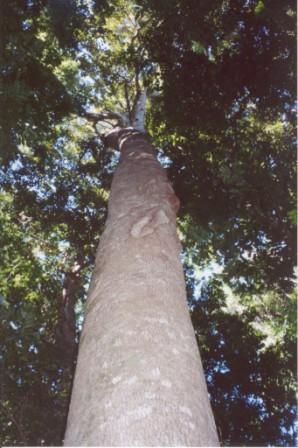
Gmelina leichhardtii, the white beech, is a tree of eastern Australia. Scattered individuals or small groups of trees naturally occur from the Illawarra district of New South Wales to near Proserpine in tropical Queensland. The white beech or grey teak is a fast-growing tree, growing on volcanic and alluvial soils in areas of moderate to high rainfall. It also grows on poorer sedimentary soils in fire free areas. White beech may occasionally be seen in Australian rainforests, though their status is considered "uncommon". Unlike the Australian red cedar, the white beech has not recovered particularly well after logging in the 19th and 20th centuries.
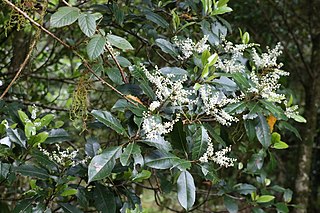
Quintinia sieberi, known as possumwood, is a rainforest tree of eastern Australia. It is mostly found in rainforests at high altitude. The range of natural distribution is between the Clyde River, New South Wales and the McPherson Range just over the border in the state of Queensland.

Backhousia leptopetala is a common Australian tree, growing from Stanwell Park in the northern Illawarra district to near Buderim in south eastern Queensland.

Arytera divaricata, known as the gap axe, coogara, coogera or rose tamarind is a forest tree of eastern Australia. An attractive plant with glossy pale and limp new leaves. It grows in fairly dry situations, often in littoral rainforests and monsoon forest.

Elattostachys nervosa, known as the green tamarind or beetroot tree is a common rainforest tree of eastern Australia. Found in all types of rainforest, growing from Paterson, New South Wales in the south to Gympie in south east Queensland. The name Elattostachys refers to "little spikes", a flower feature of other plants in this genus. Nervosa refers to the prominent leaf venation. Beetroot Tree refers to the beetroot red leaves of the new growth.
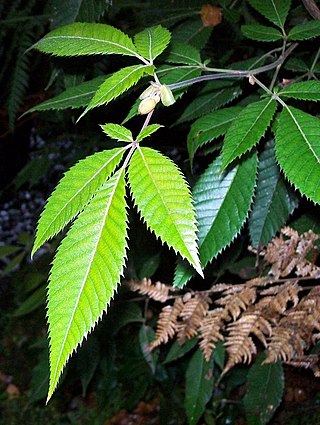
Vesselowskya venusta is a rainforest plant of restricted distribution from eastern New South Wales, Australia. The common name is Barrington Tops marara. The species name venusta is from the Latin, meaning "charming". Referring to the beauty of the long flower stems. The genus is named after the Russian botanist E. Vesselowsky.

Mallotus philippensis is a plant in the spurge family. It is known as the kamala tree or red kamala or kumkum tree, due to the fruit covering, which produces a red dye. However, it must be distinguished from kamala meaning "lotus" in many Indian languages, an unrelated plant, flower, and sometimes metonymic spiritual or artistic concept. Mallotus philippensis has many other local names. This kamala often appears in rainforest margins. Or in disturbed areas free from fire, in moderate to high rainfall areas.

Austrobuxus swainii is a rare rainforest tree in the Picrodendraceae family. It is endemic to northeast New South Wales and southeastern Queensland, Australia. Occurring from the Bellinger River in the south to Tallebudgera Creek in the north. The common names are pink cherry or hairybark. The habitat is less fertile sedimentary based soils, often associated with the coachwood, in high rainfall areas. Listed on ROTAP, as a threatened species, with a rating of 3RCa.

Cyclophyllum longipetalum, known as the coast canthium is a shrub or tree occurring in eastern Australia. Commonly seen growing in a variety of different rainforest situations. It occurs from Lake Conjola in southern New South Wales to Fraser Island in southeastern Queensland.

Endiandra introrsa is a rare rainforest tree growing in eastern Australia. Listed with a Rare or Threatened Australian Plants (ROTAP) rating of 3RCa. Its habitat is a warm temperate rainforest on the poorer rainforest soils, mostly over 300 metres in altitude, and its range of natural distribution is from near Dorrigo to various sites in the state of Queensland.

Arytera distylis, known as the two-leaved coogera or twin-leaved coogera is a rainforest tree of eastern Australia. It grows by streams or in seaside rainforests. It occurs from the Orara River in the Mid North Coast region of New South Wales, extending up to Maryborough in southeast Queensland.
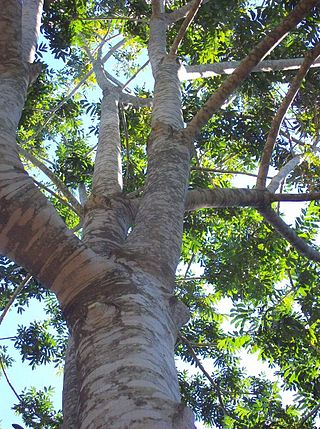
Didymocheton rufus is a rainforest tree in the family Meliaceae, found in eastern Australia. It occurs on a variety of different soils and rainforest types. From as far south as Bulahdelah, New South Wales to the McIlwraith Range in far north eastern Australia. The specific epithet rufus refers to the rusty red of the leaf, fruit and flower hairs of this species.

Mallotus claoxyloides is an Australian rainforest plant in the spurge family. Common names include green kamala, odour bush, and smell of the bush. Opinions are divided on the strong scent of the plant. Some say it is offensive and resembles a skunk while most others find the scent aromatic and delightful. Because of the scent, it is grown in gardens.
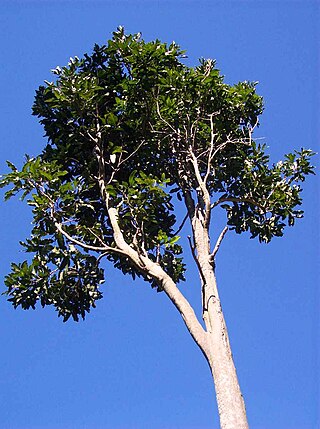
Atalaya multiflora, known as the broad leaved whitewood, is a rare and endangered rainforest tree of the soapberry family native to eastern Australia.
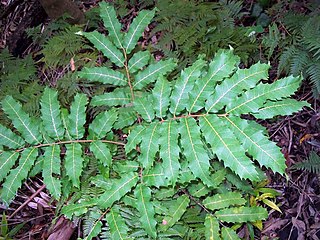
Cupaniopsis newmanii is a rainforest plant in the soapberry family. It is native to eastern Australia. The common name is long-leaved tuckeroo. A rare plant, with a ROTAP listing of 2RC-. The habitat is subtropical rainforest ranging from Mullumbimby in New South Wales to Gympie in south-eastern Queensland.

Uromyrtus lamingtonensis is a rare Australian shrub growing around the state border of New South Wales and Queensland. Like the Peach Myrtle, it has attractive pink flowers.

Quassiasp. 'Mount Nardi' is a plant found in north eastern New South Wales, Australia. An uncommon to rare plant, yet to be formally named. The original specimen was collected at Mount Nardi, not far from Nimbin, Australia.

Elattostachys xylocarpa, known as the white tamarind or short-leaf beetroot is a common rainforest tree of eastern Australia. Found in the drier rainforests, which are based on volcanic soils. From as far south as the Orara River in northern New South Wales to Bowen in tropical Queensland. The name Elattostachys refers to "little spikes", a flower feature of other plants in this genus. xylocarpa refers to the hard woody fruit.
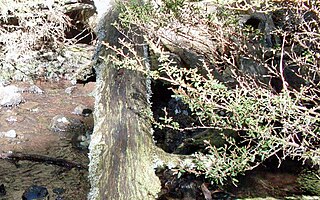
Leptospermum polygalifolium subsp. montanum known as the mountain tea tree or tantoon is a shrub or small tree found in eastern Australia. The original specimen was collected in 1912 near Yarrowitch. This plant is a sub-species of the Tantoon of the Myrtle family. It resembles other plants commonly referred to as "tea trees" or "paperbarks". The sub-species term montanum refers to its habitat of high altitudes. Polygalifolium is derived from Latin, referring to the resemblance of the leaves to certain members of the Polygala.




















